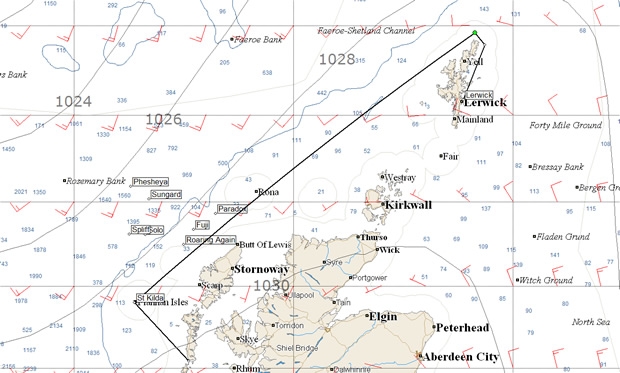All change in the Shetlands Round Britain and Ireland
Overnight the leaders in the Royal Western YC's Round Britain and Ireland Race have changed. WIth the wind moving into the southwest so yesterday's leaders, the Class 40s Marco Nannini and Paul Peggs on Sungard Front Arena and Nick Leggatt and Phillippa Hutton-Squire on Phesheya Racing have speared off to the north on port gybe, which may pay dividends in the long term, however it has allowed Will Claxton and Matt Gill on the 10m trimaran Paradox to take the lead overall with Alex Bennett and Malcolm Dickinson on Fujifilm taking the lead in the Class 40s. Both boats gybed substantially earlier than the northerly boats and are now more or less on the direct route to Muckle Flugga, the northernmost tip of the Shetland Islands.
At the 0800 sched Paradox had 213 miles to go to Muckle Flugga compared to 232 miles for Fujifilm and 247 for Sungard.
in the inter-Figaro 2 battle between Katie Miller and Matthew Lingley on bluQube and Oliver Young and Sam Goodchild on Izara, bluQube is way ahead having arrived in Barra 9 hours 24 minutes ahead. This morning bluQube is due east of the Outer Hebrides while Izara left Castle Bay in at 02:35 this morning.
Weatherwise, the leaders are currently being affected by the Azores high that is extending its reach over the British isles. The forecast indicates that there should be more pressure on the north side of the course where Phesheya Racing and Sungard Front Arena are. Sadly there is no data from the boats themselves to confirm this. We can't see the reason the boats have gone north other than to get the pressure.
Over the course of today the wind is forecast to veer from the southwest into the northwest, the shift happening to the north first but with better pressure to the southeast. By tomorrow morning the wind is set to have stabilised back in the west or WSW and dropped in pressure to around 10 knots.
Marco Nannini reports:
At the 5am position report we saw we had done well, putting 1.5 miles between us and phesheya, sailing faster and deeper along the route
suggested by the routeing software, which would take us north before gybing and laying the line to the Shetlands.
The suggested route is high risk in the sense that it takes you quite far from the shortest route and will pay off only if the weather forecast is correct.
Further south Alex Bennett is clocking up miles and looks very good on the position report, we run the routeing from his position and the
solution for him is to run along the shortest line for now then come up further north later on... his route is only marginally slower than what
we had up here in the north, and he's at the very opposite side of the playing field which makes him a very dangerous contendant to the podium, if the northerly route is a flop and the fastest route takes a southern bias we could be stuffed and pay dearly trusting the routeing solution which after all relies on a weather forecast, i'm sure you had it before that they said it was going to be sunny and then it rained, we decided we need an umbrella.
The Round Britain and Ireland winner is the yacht that makes it first to Plymouth so we discussed with Paul our options and decided to take
insurance on this leg.
We gybed over and are now sailing in the center of the field, Phesheya left and Fujifilm right, one of the two might pull off having chosen the better route but they cant be both right, so we'll hope our middle route will provide the best hedge on the long term result, as we dont want anyone putting hours of lead against us before the next leg...
Paradoxically this means we may lose our lead in Lerwick, but should manage to stay right there at the top in contention for the big prize.
Now the bad part, as we gybed we had one of the nastiest spinnaker wraps i have ever witnessed, we should have socked the sail rather then gybed traditionally, it took us an hour to clear the mess and I came very close to having to climb the mast to resolve the issue. After some maths, this cost us about 3.5 miles of lost speed, so now we have to sail even faster to claw it back.
The battle is on, we have to give the all in from here.












Latest Comments
Add a comment - Members log in